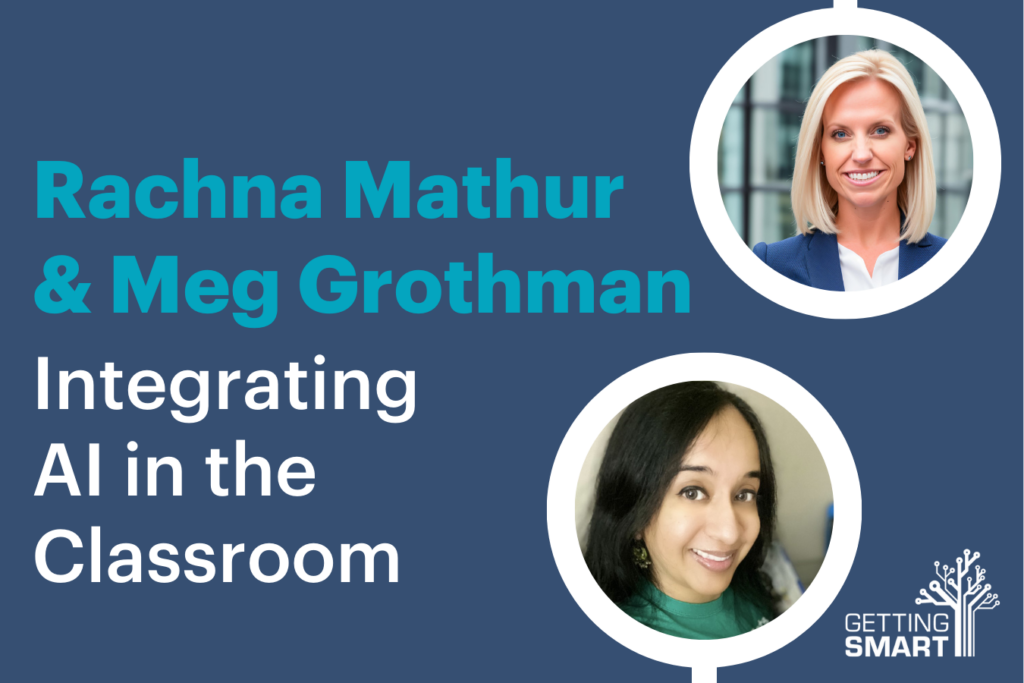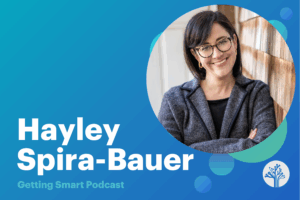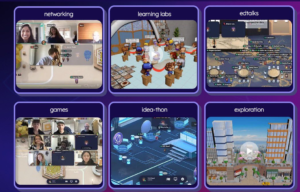Rachna Mathur and Meg Grothman on Integrating AI in the Classroom
Key Points
-
If you haven’t been playing with AI, start now.
-
AI will just be another tool unless it is used to solve a problem

On this episode of the Getting Smart Podcast, Nate McClennen is joined by Rachna Mathur, Senior STEM Strategist, CEO/Founder of Stemology Club and Meg Grothman, Director of Arizona Impact and Mathematics Innovation at ASU Prep. We have worked with ASU Prep and ASU over the years, and they both continue to live up to their reputation as innovative organizations that are inclusive rather than exclusive in who they serve. They are organizations that say yes to any solution that will help all students succeed.
This is a great conversation about AI adoption, what teachers need to know and much more.
Links:
- Rachna Mathur Website
- Megan Grothman LinkedIn
- Rachna Mathur LinkedIn
- ASU Prep
- Digit
- Teach AI – AI Strategy Deck
- Si Se Puede Foundation
- Tempe Innovation Center
Transcript
Nate: You’re listening to the Getting Smart Podcast, and I’m Nate Mclennan. Given that we are a year into easy access to AI with the launch of ChatGPT and a bunch of other tools, I thought we would sit down and have a conversation with a few leaders at one of my favorite orgs, ASU Prep, who are thinking deeply about AI and STEM and teaching and learning. Honestly, I feel that we’re on the precipice of something really big that could accelerate learning for a lot of students. But at the same time, I have this fear about the loss of community in the process and the ethical challenges that come along with it—deep fakes and all the other things that people have been talking about regarding the dangers of AI. So, collectively as an education community, we believe deeply in personalization, and we’re going to hear more about that today and the use of AI for that. But we also can’t forget the powerful impacts of humans working collectively together to solve challenges, often across differences. AI can support this as well, but it also can destroy it. I’m excited today to talk with Rachna Mathur, who is a senior STEM strategist and CEO and founder of the Stemology Club—we’ll put all the links in the show notes if you want to look into these things more—and Meg Grothman, director of Arizona Impact and Mathematics Innovation at ASU Prep. We’ve worked with ASU Prep and ASU over the years and may continue to live up to their reputation as innovative organizations that really think about being inclusive rather than exclusive in terms of who they serve. So, welcome.
Rachna Mathur: Thank you, thank you, thank you. I appreciate you inviting us. I’m excited to be here. I love having this conversation. I will have this over dinner when it comes to AI with my kids. I’m pretty sure everyone’s sick of me.
Nate: Rachna and Meg, super excited to have you here today.
Nate: Yes, a lot is happening. So, let’s jump in. Meg, maybe you start, and then Rachna, you follow up. Most influential teacher number one and the most recent task you completed with the help of a generative AI tool.
Meg Grothman: Oh my goodness, my most influential teacher that I’ve had in my life or I’ve seen teaching?
Nate: Either one.
Meg Grothman: Sure, my most influential teacher was a middle school language arts teacher who made learning so much fun. I still remember the SAT prep words she gave us. We earned little wintergreen mints, and I cannot eat one of those without thinking about her. She just absolutely made us love coming to her class every day.
Nate: That’s what we call sticky learning, right? When you eat a mint and you’re reminded of your middle school teacher. That’s amazing. Rachna, before we go, let’s talk about your most memorable teacher, and then we’ll jump back and talk about AI tools.
Rachna Mathur: Yeah, I thought about this, and that’s a very tough question. I’ve lived in so many parts of the world, too. I would say my number one are my parents. But if I pick a teacher from how we’ve learned traditionally, even though my background is in engineering, all the teachers I always remembered were in art and music. Some of the most influential were Mr. and Mrs. Seles, who taught me music and clarinet from second to eighth grade. They believed in me and let me join when I was late in joining. What stuck with me was them believing in me and the fact that they didn’t make me stay within the system. I missed the deadlines, I didn’t have the money, but they figured out ways that I could afford the clarinet and still be part of the classroom and learn to play. That affected everything I do in a very integrated way. I look at art and STEM together, collectively, and that set my mindset. So, yeah, they are two of the people I always remember.
Nate: I am also a clarinet player. I haven’t played the clarinet in a long, long time, but I appreciate that intersection of the arts and the STEM worlds. Too often, I mean, of course, sometimes we put that together in the STEAM acronym. But so much of science and math involves creativity and thinking about problem-solving and things like that. So, Rachna, back to you. What was the most recent task you completed with the help of a generative AI tool?
Rachna Mathur: Oh yeah, that’s right. So, I play with a lot of tools every single day as part of just exploration. But when it comes to AI, maybe because of just the world and life I’m in at the moment, which involves being a student, worker, and parent, I end up gravitating towards productivity tools. I do spend a lot of time with the creative art tools, but I gravitate towards productivity tools. My biggest ones are always like the AI note-taker that’s on Zoom, and I try different ones. And then ChatGPT is always a great thought partner. I’m always working on improving how I’m prompting it and how I’m interacting and going back and forth as a thought partner versus an answer engine. That’s probably my go-to. And I know Meg—oh my gosh, Meg’s a guru in the way she can thought partner with ChatGPT, and I always appreciate that.
Nate: All right, Meg.
Meg Grothman: Yeah, Nate, I used it this week to organize a set of slides for a presentation that I’m doing on Thursday. Of course, I’ve procrastinated, and instead of staring at a blank slide deck, I now have at least different themes and units for me to go through. It didn’t make the slides—it will make the slides for you if you want it to—that isn’t the part that I really needed help with. It’s just getting started. At home, I look in the fridge and say, “I have pork, green onions, soy sauce. What can I make?”
Nate: Oh, it’s brilliant.
Meg Grothman: Yes, the last-minute meal prep. Tell me what I could…
Rachna Mathur: Oh, I love that. I need to try that.
Nate: I love it. It’s like ChatGPT Chef. I’m definitely trying that as well. I’m sure it’s in the marketplace already. I think my most recent was—we work a lot with competencies and creating progressions for those competencies in K-12 education. I asked, given a set of competencies, to create a progression over five levels from kindergarten to twelfth grade with the language for each, and it did a really good job. I had to refine the prompt a little bit, but it saved a ton of time in creating some foundational work for humans to go noodle, work, and create something usable for their community. Appreciate that. So, Meg, maybe I loved it for our audience to know a little bit about both of you. ASU and ASU Prep are complicated organizations. What I can tell our audience is that ASU Prep is a public charter school authorized by ASU, a large innovative global university. Meg, what is your role, and how do you sit within that matrix?
Meg Grothman: Sure, absolutely. I’m actually in my tenth year at ASU Prep Academy. I started as a high school math teacher at our downtown prep campus. Now, my role has developed into a very unique situation where I support mathematics innovation. What that means is product development, instructional strategies, and programmatic support for not just our prep campuses but schools around the state of Arizona. That’s where my Arizona Impact work comes into play, where I get to leverage assets and programs from the university as well as prep to impact student learning and outcomes across the state. I bring resources to different school districts, and we partner with them. On the flip side, I’ve learned what’s going on in these amazing schools around our state and share those things, increasing networking opportunities.
Nate: Got it. So, are they using the ASU Prep Digital Math curriculum, or is there a number of tools that you’re supporting districts with?
Meg Grothman: There are a number of tools. It could be curriculum, my impact work expands further than math. It’s all subjects and all grades. It could be curriculum resources, digital teachers, professional development for teachers, university programs, university courses. It could be setting up the innovation lab. How can we incorporate fifth-grade science? Let’s put our heads together and figure out what to do. I truly have a dream job of being able to say yes to as many things as I can.
Nate: Awesome! Awesome! Rachna, same question to you, and also talk to us a little bit about the Stemology Club. I’m super intrigued. I jumped on that website, and there’s a lot going on there, so talk about both ASU and Stemology.
Rachna Mathur: Thank you. Yeah, absolutely. I’m really excited to have joined ASU Prep in this last year. I come from maybe a nontraditional path—I don’t come through and through from education. I started the first half of my career at Intel, over a decade, where I worked in the semiconductor industry, software development, coding, that kind of thing. I’m a Sun Devil all the way because I’ve done both my degrees from Fulton. Over time, as I discovered perhaps having children, perhaps just the community educator in me—I’ll always say community educator, one a little bit outside of the system—I started Stemology Club out of a need at my kid’s school. She was in second grade at that time; she’s in seventh now. That started off really slow, and it was a platform to support educators, community educators, and students to have some organized hands-on activities for STEM. It was kind of like a microservice. Over time, it grew and grew because I found this intersection of, “We need to do things in our classroom,” but then there was this very big need to get the community involved, and we found different ways to do that.
Rachna Mathur: Over time, I found myself connecting with the larger community, city councils, people at the county level, the state level. I was on the Computer Science Task Force for the state of Arizona, and I took all of those learnings and brought them into my classroom, into my club, and started training teachers. Over time, I’ve just found myself collaborating with people like Meg and ASU and ASU Prep, and we came to this point where we found we were doing a lot of things in common. That’s when I came in here. My formal title, like you mentioned, is Senior STEM Strategist, but the thing that I find interesting in the work that we do here is we’re both an educational institution and a research organization. What we’re doing here is often leading the edge of research, where I get to marry a lot of my experiences from the industry, the community, and the government.
Nate: Fantastic, and I’m excited to see where ASU Prep is headed and how we might continue to engage together. Let’s dive into some AI talk now. You know, it’s interesting, the surveys say something like 80% of adults have tried ChatGPT or some other generative AI tool, but that might mean just once. I feel like we are still in the early stages, and there’s a lot of fear and misunderstanding. How are you thinking about AI at ASU Prep, and what are some of the key themes that are emerging?
Rachna Mathur: Yeah, so the way we look at AI—and we’ve done this in partnership with ASU Prep Digital too—our biggest focus is on the ethical use of AI. We’re very much invested in not just looking at it as a tool but understanding the underpinnings of it. What are the ethical considerations? We actually created a whole course on the ethics of AI for high school students. The goal was to have them understand the technology, how it works, the biases that can be baked into it, and how to use it responsibly. We also encourage our teachers to use it as a co-teacher. Instead of seeing it as a replacement, it’s an enhancement tool. It’s like having another teacher in the classroom that can give personalized feedback or help create materials.
Meg Grothman: And I think what Rachna said is key: it’s about integration and enhancement. We don’t see AI as a threat; we see it as an opportunity to personalize learning at scale. We use it to help teachers with administrative tasks, so they can focus more on teaching. We’re also exploring AI’s potential in providing real-time feedback to students, something that can be game-changing. But again, it all comes back to using it responsibly.
Nate: That’s really insightful. I appreciate the focus on ethics and responsibility. It’s crucial as we navigate this new frontier. I’m curious, though, about the practical applications you’re seeing. Can you give some examples of how AI is currently being used in classrooms at ASU Prep?
Meg Grothman: Absolutely. One of the most practical applications we’ve implemented is the use of AI-powered tutoring tools. These tools provide instant feedback on assignments, which allows students to learn and correct mistakes in real time. Another application is in personalized learning plans. AI helps us create tailored educational experiences for each student based on their strengths, weaknesses, and learning styles. We also use AI to analyze student data and predict who might need extra help, allowing us to intervene before small issues become big problems.
Rachna Mathur: And to add to that, we’re experimenting with AI in project-based learning. For example, students can use AI tools to help them research topics, organize their thoughts, and even generate initial drafts for their projects. This way, they can focus more on the creative and critical thinking aspects of their work. Additionally, we’re looking into using AI to support teacher professional development, offering personalized training and resources based on individual teacher needs and goals.
Nate: Those are great examples. It sounds like there’s a lot of potential for AI to support both teachers and students. But with all this potential, there must be challenges too. What are some of the biggest hurdles you’ve encountered or anticipate encountering with the integration of AI in education?
Rachna Mathur: One of the biggest challenges is ensuring equity. Not all students have the same level of access to technology, and we need to be mindful of that. Another challenge is the potential for AI to perpetuate biases. If the data used to train AI models is biased, the outputs will be too. We’re working hard to mitigate these risks by being very selective about the data we use and continually refining our models to be as fair and unbiased as possible.
Meg Grothman: I agree with Rachna. Another challenge is teacher training. Not all teachers are comfortable with AI or understand how to use it effectively. We’re investing a lot in professional development to help teachers feel confident and competent in using AI tools. Finally, there’s the challenge of keeping up with the rapid pace of AI development. Technology evolves so quickly, and it can be hard to stay ahead of the curve. But that’s also part of the excitement—there’s always something new to learn and explore.
Nate: Absolutely, and it sounds like you’re both doing incredible work to navigate these challenges. As we wrap up, what advice would you give to other educators and school leaders who are just starting to explore AI in their institutions?
Rachna Mathur: My advice would be to start small. You don’t need to implement everything at once. Begin with a pilot project or a single tool that addresses a specific need. Also, involve your teachers and students in the process. Get their feedback and make adjustments based on what works and what doesn’t. And most importantly, keep the focus on ethical use and equity.
Meg Grothman: I would add to that by saying, don’t be afraid to experiment and fail. Innovation comes with risks, but those risks are worth taking if they lead to better learning outcomes. Also, leverage the resources and expertise around you. Collaborate with other schools, universities, and tech companies. There’s a lot of support out there, and you don’t have to go it alone.
Nate: Great advice. Thank you both for sharing your insights and experiences. I’m sure our listeners will find this conversation incredibly valuable. Rachna and Meg, it’s been a pleasure having you on the podcast today.
Rachna Mathur: Thank you, Nate. It’s been a great conversation.
Meg Grothman: Thanks, Nate. Really enjoyed it.Nate: And thank you to our listeners for tuning in to the Getting Smart Podcast. We’ll catch you next time.









0 Comments
Leave a Comment
Your email address will not be published. All fields are required.